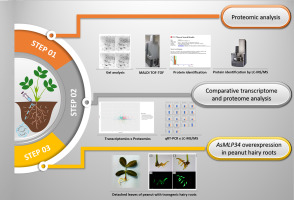当前位置:
X-MOL 学术
›
J. Proteomics
›
论文详情
Our official English website, www.x-mol.net, welcomes your
feedback! (Note: you will need to create a separate account there.)
Proteomics unravels new candidate genes for Meloidogyne resistance in wild Arachis.
Journal of Proteomics ( IF 2.8 ) Pub Date : 2020-02-14 , DOI: 10.1016/j.jprot.2020.103690 Andressa C Q Martins 1 , Angela Mehta 2 , André M Murad 2 , Ana P Z Mota 3 , Mário A P Saraiva 2 , Ana C G Araújo 2 , Robert N G Miller 4 , Ana C M Brasileiro 2 , Patrícia M Guimarães 2
Journal of Proteomics ( IF 2.8 ) Pub Date : 2020-02-14 , DOI: 10.1016/j.jprot.2020.103690 Andressa C Q Martins 1 , Angela Mehta 2 , André M Murad 2 , Ana P Z Mota 3 , Mário A P Saraiva 2 , Ana C G Araújo 2 , Robert N G Miller 4 , Ana C M Brasileiro 2 , Patrícia M Guimarães 2
Affiliation

|
Arachis stenosperma is a wild peanut relative exclusive to South America that harbors high levels of resistance against several pathogens, including the peanut root-knot nematode (RKN) Meloidogyne arenaria. In this study, a proteomic survey of A. stenosperma-M. arenaria interaction using 2-DE and LC-MS/MS identified approximately 1400 proteins, out of which 222 were differentially abundant (DAPs) when RKN inoculated root samples were compared to the control. Most of these DAPs were assigned to functional categories related to plant responses to pathogens including stress, glycolysis, redox and tricarboxylic acid cycle. The comparison between the transcriptome (RNA-Seq) and proteome expression changes, showed that almost 55% of these DAPs encode genes with a similar expression trend to their protein counterparts. Most of these genes were induced during RKN infection and some were related to plant defense, such as MLP-like protein 34 (MLP34), cinnamoyl-CoA reductase 1 (CCR1), enolase (ENO), alcohol dehydrogenase (ADH) and eukaryotic translation initiation factor 5A (eIF5A). The overexpression of AsMLP34 in Agrobacterium rhizogenes transgenic roots in a susceptible peanut cultivar showed a reduction in the number of M. arenaria galls and egg masses, indicating that AsMLP34 is a promising candidate gene to be exploited in breeding programs for RKN control in peanut. SIGNIFICANCE: The use of an integrated approach to compare plant-nematode transcriptional and translational data enabled the identification of a new gene, AsMLP34, for Meloidogyne resistance.
中文翻译:

蛋白质组学揭示了野生花生中抗Meloidogyne的新候选基因。
花生花生属(Arachis stenosperma)是南美唯一的野生花生,对几种病原体(包括花生根结线虫(RKN)Meloidogyne arenaria)具有很高的抗性。在这项研究中,A。stenosperma-M的蛋白质组学调查。使用2-DE和LC-MS / MS进行的紫锥花相互作用鉴定出大约1400种蛋白质,当将RKN接种的根样品与对照进行比较时,其中222种差异丰富(DAP)。这些DAP中的大多数被归类为与植物对病原体的反应有关的功能类别,包括胁迫,糖酵解,氧化还原和三羧酸循环。转录组(RNA-Seq)和蛋白质组表达变化之间的比较表明,这些DAP中近55%编码的基因表达趋势与蛋白质相似。这些基因大多数是在RKN感染过程中诱导的,有些与植物防御相关,例如MLP样蛋白34(MLP34),肉桂酰辅酶A还原酶1(CCR1),烯醇酶(ENO),醇脱氢酶(ADH)和真核翻译起始因子5A(eIF5A)。在易感花生品种的发根农杆菌转基因根中,AsMLP34的过量表达表明,槟榔分枝杆菌和卵团的数量减少,这表明AsMLP34是有望用于花生RKN控制育种程序的候选基因。重要性:使用整合的方法比较植物线虫的转录和翻译数据,可以鉴定出对根结线虫抗性的新基因AsMLP34。肉桂酰辅酶A还原酶1(CCR1),烯醇酶(ENO),醇脱氢酶(ADH)和真核翻译起始因子5A(eIF5A)。在易感花生品种的发根农杆菌转基因根中,AsMLP34的过量表达表明,槟榔分枝杆菌和卵团的数量减少,表明AsMLP34是一个有前途的候选基因,可用于花生RKN控制的育种程序中。重要性:使用整合的方法比较植物线虫的转录和翻译数据,可以鉴定出对根结线虫抗性的新基因AsMLP34。肉桂酰辅酶A还原酶1(CCR1),烯醇酶(ENO),醇脱氢酶(ADH)和真核翻译起始因子5A(eIF5A)。在易感花生品种的发根农杆菌转基因根中,AsMLP34的过量表达表明,槟榔分枝杆菌和卵团的数量减少,这表明AsMLP34是有望用于花生RKN控制育种程序的候选基因。重要性:使用整合的方法比较植物线虫的转录和翻译数据,能够鉴定出对根结线虫抗性的新基因AsMLP34。在易感花生品种的发根农杆菌转基因根中,AsMLP34的过量表达表明,槟榔分枝杆菌和卵团的数量减少,这表明AsMLP34是有望用于花生RKN控制育种程序的候选基因。重要性:使用整合的方法比较植物线虫的转录和翻译数据,能够鉴定出对根结线虫抗性的新基因AsMLP34。在易感花生品种的发根农杆菌转基因根中,AsMLP34的过量表达表明,槟榔分枝杆菌和卵团的数量减少,表明AsMLP34是一个有前途的候选基因,可用于花生RKN控制的育种程序中。重要性:使用整合的方法比较植物线虫的转录和翻译数据,可以鉴定出对根结线虫抗性的新基因AsMLP34。
更新日期:2020-02-20
中文翻译:

蛋白质组学揭示了野生花生中抗Meloidogyne的新候选基因。
花生花生属(Arachis stenosperma)是南美唯一的野生花生,对几种病原体(包括花生根结线虫(RKN)Meloidogyne arenaria)具有很高的抗性。在这项研究中,A。stenosperma-M的蛋白质组学调查。使用2-DE和LC-MS / MS进行的紫锥花相互作用鉴定出大约1400种蛋白质,当将RKN接种的根样品与对照进行比较时,其中222种差异丰富(DAP)。这些DAP中的大多数被归类为与植物对病原体的反应有关的功能类别,包括胁迫,糖酵解,氧化还原和三羧酸循环。转录组(RNA-Seq)和蛋白质组表达变化之间的比较表明,这些DAP中近55%编码的基因表达趋势与蛋白质相似。这些基因大多数是在RKN感染过程中诱导的,有些与植物防御相关,例如MLP样蛋白34(MLP34),肉桂酰辅酶A还原酶1(CCR1),烯醇酶(ENO),醇脱氢酶(ADH)和真核翻译起始因子5A(eIF5A)。在易感花生品种的发根农杆菌转基因根中,AsMLP34的过量表达表明,槟榔分枝杆菌和卵团的数量减少,这表明AsMLP34是有望用于花生RKN控制育种程序的候选基因。重要性:使用整合的方法比较植物线虫的转录和翻译数据,可以鉴定出对根结线虫抗性的新基因AsMLP34。肉桂酰辅酶A还原酶1(CCR1),烯醇酶(ENO),醇脱氢酶(ADH)和真核翻译起始因子5A(eIF5A)。在易感花生品种的发根农杆菌转基因根中,AsMLP34的过量表达表明,槟榔分枝杆菌和卵团的数量减少,表明AsMLP34是一个有前途的候选基因,可用于花生RKN控制的育种程序中。重要性:使用整合的方法比较植物线虫的转录和翻译数据,可以鉴定出对根结线虫抗性的新基因AsMLP34。肉桂酰辅酶A还原酶1(CCR1),烯醇酶(ENO),醇脱氢酶(ADH)和真核翻译起始因子5A(eIF5A)。在易感花生品种的发根农杆菌转基因根中,AsMLP34的过量表达表明,槟榔分枝杆菌和卵团的数量减少,这表明AsMLP34是有望用于花生RKN控制育种程序的候选基因。重要性:使用整合的方法比较植物线虫的转录和翻译数据,能够鉴定出对根结线虫抗性的新基因AsMLP34。在易感花生品种的发根农杆菌转基因根中,AsMLP34的过量表达表明,槟榔分枝杆菌和卵团的数量减少,这表明AsMLP34是有望用于花生RKN控制育种程序的候选基因。重要性:使用整合的方法比较植物线虫的转录和翻译数据,能够鉴定出对根结线虫抗性的新基因AsMLP34。在易感花生品种的发根农杆菌转基因根中,AsMLP34的过量表达表明,槟榔分枝杆菌和卵团的数量减少,表明AsMLP34是一个有前途的候选基因,可用于花生RKN控制的育种程序中。重要性:使用整合的方法比较植物线虫的转录和翻译数据,可以鉴定出对根结线虫抗性的新基因AsMLP34。











































 京公网安备 11010802027423号
京公网安备 11010802027423号